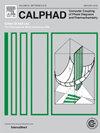Experimental phase diagram study of the Ni-rich part of the Ni–Cr–Mo ternary system
IF 1.9
3区 材料科学
Q4 CHEMISTRY, PHYSICAL
Calphad-computer Coupling of Phase Diagrams and Thermochemistry
Pub Date : 2025-01-30
DOI:10.1016/j.calphad.2025.102802
引用次数: 0
Abstract
Experimental studies were conducted to investigate the phase equilibria of the Ni-rich portion of the Ni–Cr–Mo ternary system using scanning electron microscopy and electron probe microanalysis of heat-treated alloys. Experimental isothermal sections involving L-liquid, γ-Ni, P-NiCrMo, NiMo, Ni3Mo, and Ni2(Cr, Mo)-oP6 phases were constructed at temperatures below 1573 K. Two distinct liquid phase regions with varying compositions were observed at 1573 K, indicating a phase separation of the liquid phase (L → L1 + L2). This can result in the presence of two ternary eutectic reactions: L1 → γ + P + NiMo and L2 → γ + σ + P. The Ni2Cr phase in the binary system was stabilized by substituted Cr by Mo at temperatures above 200 K. The Ni2(Cr, Mo)-oP6 single-phase region existed as an island around the composition of Ni–9Cr–24Mo (at.%) at 1073 K. The experimentally identified γ + oP6 + Ni3Mo and γ + P + oP6 regions suggest that the oP6 phase is formed by a ternary peritectoid reaction (γ + P + Ni3Mo → oP6). Based on these results, the reaction pathways related to the liquid and oP6 phases in the Ni–Cr–Mo ternary system were modified.
Ni-Cr-Mo三元体系富镍部分的实验相图研究
利用扫描电镜和电子探针对热处理合金进行了富镍部分的相平衡研究。在1573 K以下的温度下,构建了l -液相、γ-Ni、P-NiCrMo、NiMo、Ni3Mo和Ni2(Cr, Mo)-oP6相的实验等温切片。在1573 K时观察到两个不同组成的明显液相区,表明液相发生了相分离(L→L1 + L2)。这可以导致两个三元共晶反应的存在:L1→γ + P + NiMo和L2→γ + σ + P。在200 K以上的温度下,用Mo取代Cr可以稳定二元体系中的Ni2Cr相。在1073 K时,Ni2(Cr, Mo)-oP6单相区在Ni-9Cr-24Mo (at.%)组分周围呈岛状存在。实验鉴定的γ + oP6 + Ni3Mo和γ + P + oP6区域表明,oP6相是由三元类周反应(γ + P + Ni3Mo→oP6)形成的。在此基础上,对Ni-Cr-Mo三元体系中液相和oP6相的反应路径进行了修正。
本文章由计算机程序翻译,如有差异,请以英文原文为准。
求助全文
约1分钟内获得全文
求助全文
来源期刊
CiteScore
4.00
自引率
16.70%
发文量
94
审稿时长
2.5 months
期刊介绍:
The design of industrial processes requires reliable thermodynamic data. CALPHAD (Computer Coupling of Phase Diagrams and Thermochemistry) aims to promote computational thermodynamics through development of models to represent thermodynamic properties for various phases which permit prediction of properties of multicomponent systems from those of binary and ternary subsystems, critical assessment of data and their incorporation into self-consistent databases, development of software to optimize and derive thermodynamic parameters and the development and use of databanks for calculations to improve understanding of various industrial and technological processes. This work is disseminated through the CALPHAD journal and its annual conference.

 求助内容:
求助内容: 应助结果提醒方式:
应助结果提醒方式:


